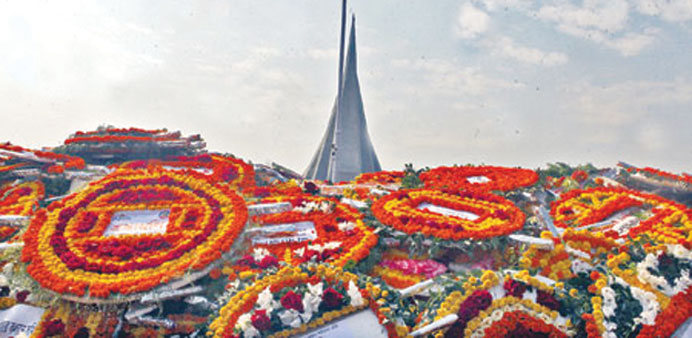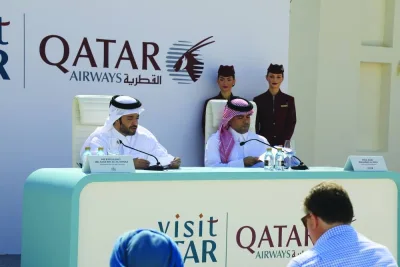By Mizan Rahman/Dhaka
Bangladesh Nationalist Party (BNP) chairperson Khaleda Zia did not appear at the National Mausoleum at Savar on the northern outskirts of the capital yesterday to pay homage to martyred war heroes on Independence Day. She also skipped Shaheed Minar too on the occasion of the memorial function marking the 1952 language movement.
However, some BNP leaders and activists, led by its standing committee members Lt Gen (retd) Mahbubur Rahamn and Abdul Moyeen Khan, placed wreaths at the National Mausoleum around 8am on behalf of the party.
After placing the wreaths, they stood in silence for a while as a mark of respect to the sons of the soil who embraced martyrdom during the nine-month war of independence against Pakistani occupation forces.
BNP vice chairman Altaf Hossain Chowdhury, chairperson’s adviser Shahjahan Omar, Enam Ahmed Chowdhury, Abdul Mannan, central leaders Mostafizur Rahman Babul, Asadul Karim Shaheen, Sramik Dal president Anwar Hossain, women’s wing president Nure Ara Safa and Ulema Dal president Abdul Malek were, among others, present.
Later, the two BNP standing committee members along with party leaders and activists visited party founder late president Ziaur Rahman’s grave at Sher-e-Bangla Nagar and placed wreaths there.
Khaleda has been staying in her Gulshan political office since January 3 and has not come out even once over the last two and a half months.
Despite the issuance of a warrant for her arrest in two graft cases which is still effective, the BNP chief has not shown up before the court seeking bail. She also did not go to the Shaheed Minar on February 21 onthe occasion of the International Mother Language Day.
Party sources said Khaleda is not coming out of her office fearing that government may not allow her to return to her Gulshan office once she leaves it.
As Bangladesh yesterday marked its 45th Independence Day, Bangladeshis are unable to visit most of the sites linked to the 1971 liberation war as these are still to be identified even after 44 years of freedom.
These include major battlefields, staging posts for guerilla operations and many torture cells and camps run by Pakistani military and their collaborators.
Liberation war affairs ministry sources said that they had built memorials at 13 frontline battle zones in 10 districts but did not know if the places where freedom fighters had carried out major operations, and torture cells and camps use by the Pakistani military and their local auxiliaries to torture and kill freedom fighters and violate women had been preserved as memorials.
Liberation war researchers said that the government should build war memorials at the major sites and identify such other places and at least set up plaques there after demarcation for preservation.
There are at least 720 such sites across Bangladesh, including battlefields, staging posts and torture cells and camps, according to Liberation War Museum general manager AKM Mahbub Ul Alam.
Liberation war affairs minister AKM Mozamel Huq said that it was very important to preserve the sites linked to the history of the 1971 liberation war and that the government has a plan to preserve those places.
In the frontline battles, and particularly in the final days of the liberation war, many freedom fighters died in combats and during the nine months of war, over two lakh women were raped and many people were tortured and killed in the camps run by the Pakistan army and their collaborators.
Rajarbagh Police Lines resistance, battle of Daruin in Comilla and battle of Rangamati-Mahalchari waterway in Chittagong Hill Tracts, Bangladesh naval commando operation codenamed Operation Jackpot, the Bangladesh Air Force attack on a Pakistani oil depot near Chittagong seaport, fighting at Kaddar More in Siddhirganj of Narayanganj, the battles at Kamalpur in Jamalpur, Akhaura in Brahamanbaria, Chilmari in Kurigram, Jahazmara in Tangail and the guerilla operation in Dhaka to kill Abdul Monem Khan, governor of the then East Pakistan, are some of the major events of the liberation war.
Mahbub Ul Alam said the 720 places included 55 battlefields, 119 in the final days of the war, 342 places across the 11 sectors and 42 places where Kadeira Bahini, Afsar Bahini, Baten Bahini and Hemayet Bahini fought battles.
There are 21 more places linked to the events of the preparatory period of the liberation war and 44 cells and camps where the Pakistan military and their collaborators used to torture freedom fighters and violate women.
A two-volume book titled ‘Guerilla Theke Sammukh Juddhey’ (Frontal battle from Guerilla warfare) written by Mahbub Alam and published by Shahitya Prakash and Volumes IX, X and XI of the History of Bangladesh War of Independence, published by the Bangladesh Government, have documented accounts of several hundred battles and guerrilla operations.
Besides, killing fields and mass graves discovered after the liberation war are gradually disappearing for lack of preservation. Private organisations and war researchers put the number of such mass graves and killing fields between 1,000 and 5,000. The ministry, however, identified 204 mass killing fields and mass graves that were left uncared for, covered with weeds.
The War Crimes Facts Finding Committee, Bangladesh, said that there were over 5,000 mass graves and killing fields across the country. It identified more than 940 such spots many of which cannot be traced now. The Liberation War Museum listed 467 killing fields and mass graves across the country. A volume on the independence war has listed about 1,000 mass graves and killing fields, Muntassir Mamoon, who edited the series, said.
War Crimes Facts Finding Committee convener MA Hasan said many of the places linked to the liberation war history went into oblivion because lack of initiatives to preserve them.
“The government’s efforts were never enough to preserve such places,” he said.
Liberation war researcher and historian Abu Mohammad Delwar Hossain said the situation was so frustrating that that after some years it would be difficult for someone to understand what had actually happened in 1971.
“Most of such places do not have even signs,’ he added.
Liberation war affairs ministry sources said that it already had instructed field level offices, including deputy commissioner’s offices in each districts, to prepare a list of such places and sent it to the ministry.
“We have lists from about 20 districts,” said Sufi Abdullhil Maruf, information officer of the ministry who is responsible for collecting the lists.
He said the ministry would review the lists and try to set up memorials at the places linked to the liberation war.

The National Mausoleum


